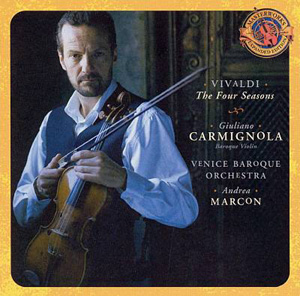 Vivaldi’s The Four Seasons is arguably one of the most performed, and certainly among the most heard, of Baroque masterpieces, having made its way from musty libraries to concert halls to shopping malls. It is seldom that one is able to come to this work with fresh ears, but happily, the Sony Masterworks recording by Giuliano Carmignola, Andrea Marcon and the Venice Baroque Orchestra makes that possible.
Vivaldi’s The Four Seasons is arguably one of the most performed, and certainly among the most heard, of Baroque masterpieces, having made its way from musty libraries to concert halls to shopping malls. It is seldom that one is able to come to this work with fresh ears, but happily, the Sony Masterworks recording by Giuliano Carmignola, Andrea Marcon and the Venice Baroque Orchestra makes that possible.
As Paul Myers points out in his essay accompanying this recording, this is a work that, within the forms of its time, foreshadows many of the characteristics of the Romantic period, which reached its full promise about one hundred years later. Vivaldi wrote a sonnet for each movement, as a means of fixing the program (reinforced by notations on “special effects” in the original score). And indeed, one can hear in the music the spring storms that the sonnet describes, as well as the languid days of summer — with another storm — the happy harvest festival leading to slumber (from over-imbibing the god’s bounty, according to Vivaldi), and finally the joyful play of crisp winter days. This is music that, while it fully reflects the forms of the early eighteenth century, is not really in its inception “court” music; it is, rather, music that takes its impetus from life in the countryside — think of the difference between a Fragonard rural fantasy and the deeper vision of Watteau.
Myers also points out (old news to those familiar with Baroque music, or early drama, for that matter) that composers left ample room for their interpreters to add their own fugitive contributions. Carmignola makes full use of this characteristic, adding his own skillful — and never inappropriate — cadenzas.
The Locatelli concerti are gems, engaging and substantial virtuoso works that incorporate some demanding passages for the solo violin. Both works presented here are from Locatelli’s Opus 3, L’Arte del violino, a group of twelve concerti for violin, strings and bass continuo. Hearing these, it’s somewhat puzzling that violinists waited so long to bring them to the surface — they are beautiful and provide ample opportunity to showcase an accomplished master. They were also quite influential on Locatelli’s contemporaries.
The personnel for this recording are as impressive as the works themselves. Carmignola is from a distinguished musical family. After his studies with his father, Antonio, he studied with such luminaries as Nathan Milstein and Henryk Szering, and went on to win a number of international competitions. He has concentrated in recent years on the Baroque music of Italy. He is joined in this recording by Andrea Marcon, a leading interpreter of the Italian Baroque, who is much sought after as a harpsichord soloist and is conductor of the Venice Baroque Orchestra, which he founded in 1997. The Orchestra has presented the first modern performances of works by Monteverdi, Vivaldi, Cavalli and others, and has worked with the Teatro La Fenice in staging long-forgotten operas by Handel and Cavalli. The performers are admirably suited to the work and provide extraordinary interpretations, all using period instruments. These are all performances from 1999 and 2001, and are presented on the disc with great clarity and precision.
There are many excellent recordings of The Four Seasons available these days, as might be guessed from its ubiquity. The addition of the Locatelli offerings, however, gives this one an edge, and provide a worthy introduction to a little-known Baroque master.
(Sony Musical Entertainment, 2002)
